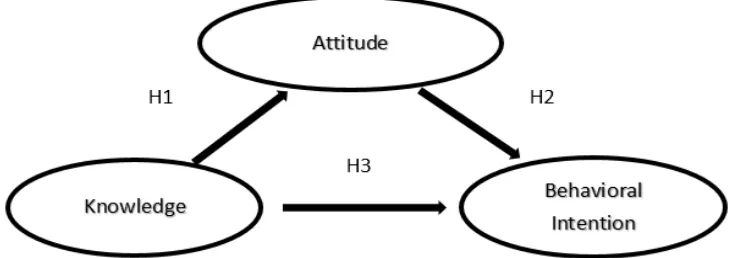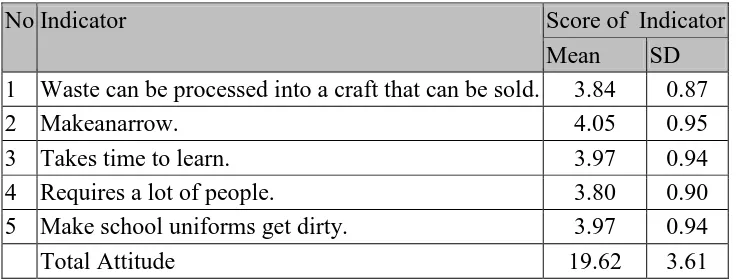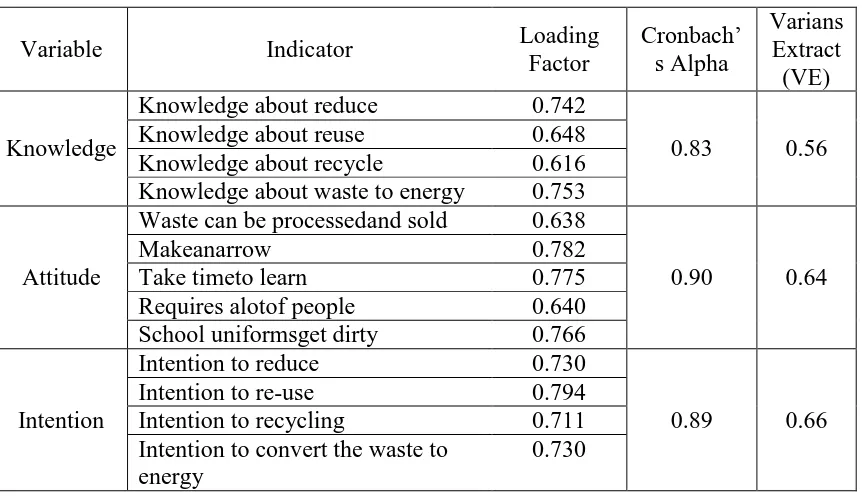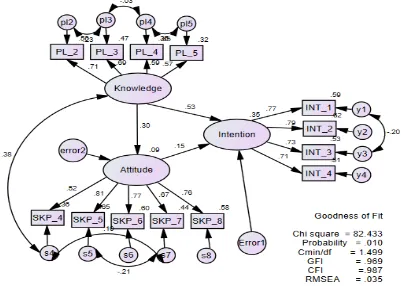ISSN 0973-6077 Volume 11, Number 5 (2016), pp. 1323-1332 © Research India Publications
http://www.ripublication.com
The Relationship of Knowledge, Attitudes, and
Behavioral Intentions of Sustainable Waste
Management on Primary School Students in
City of Padang, Indonesia
Aria Gusti*
*Faculty of Public Health, Andalas University, Padang, Indonesia.
Abstract
This study examined the intention of sustainable waste management behavior in elementary school student by using the framework of the Theory of Planned Behavior. The purpose of this study was to determine the relationship of knowledge, attitudes, and behavioral intentions of sustainable waste management. Population and sample in this study is elementary school students in the city of Padang, West Sumatra. The data collected for this study were analyzed using Structural Equation Modeling (SEM). The results of this study stated that the knowledge about sustainable waste management has a significant relationship with attitudes towards sustainable waste management. Knowledge and attitudes towards sustainable waste management has a significant relationship with the intention of sustainable waste management behavior. These findings have important implications for the school as well as for policy makers.
Keywords: Sustainable Waste Management, Knowledge, Attitude, Behavioral Intention
INTRODUCTION
Unsanitary disposal of waste is one of the biggest challenges faced by developing countries. This issue is recorded by all countries at the 1992 Conference on Environment and Development (UNCED) as the major barrier path toward sustainability.(2) Thus, proper waste management is needed to ensure the protection of the environment and human health.
Sustainable waste management becomes an acute need to address the negative impact of waste and environmental preservation. Sustainable waste management is regarded as an effective measure to reduce the cost of collecting, transporting and processing waste.(3) Sustainable waste management behavior is defined as a efforts to reduce waste (reduce), reusing goods that are still feasible to use (reuse), recycling (recycle), and turning waste into energy sources (waste to energy).
Understanding and explain the behavior of waste management can use the approach of psychology theories about the relationship of knowledge, attitudes and behavior. Cognitive or knowledge is very important domain for the formation of a person's actions, knowing from experience and research results turned out behavior based on knowledge will be better than not based on knowledge.Studies investigating the relationship between knowledge, attitudes and behaviors known as the study of KAP (knowledge, attitudes and practices). This study explains what people know about something, what he feels, and how he behaves.(4) The investigation method is used widely around the world in the field of public health, water supply and sanitation, education and many other programs
The knowledge possessed by students refer to their understanding of the topics of interest for example for this study is on sustainable waste management. Attitudes refer to their feelings towards sustainable waste management, as well as ideas preconceived which may lead to it. The practice refers to the way they show the knowledge and attitudes through their actions in implementing sustainable waste management.
Padang as the largest city in West Sumatra province facing the waste problem that needs serious handling, which is waste generation continues to increase every year. Based on previous studies reference the average urban waste generation is 0.0035 m3/ person / day, equivalent to 0.9 kg / person / day. In 2013 with a population of 871 534 inhabitants estimated daily amount of waste in the city of Padang reached 3.050 m3 (784 tons), while only 400 tons / hr (51%) of waste generation can be transported up in landfills in Air Dingin Village.
Sustainable waste management should be of concern to everyone, from children to adult relatives, rich or poor. establishment of a sustainable waste management behavior in primary school students oriented to sustainable development can be a role model for the behavior of a sustainable waste management in their families and communities. The relationship between knowledge, attitudes, and behavioral intentions of sustainable waste management is a problem that want to obtain the answer in this study.
RESEARCH METHODS
The study was conducted in the city of Padang, Indonesia. A total of 400 students were subsequently randomly selected respondents in four schools proportional sampling. There are three variables used, which is knowledge, attitudes, and behavioral intentions. Further data collection instruments is determined based on the study variables. The data collection was conducted by questionnaire and interview. This study used survey method with cross sectional design where the data of all study variables were collected at the same time. Analysis of the relationship and influence in this study using Structural Equation Modelling (SEM). SEM are statistical techniques that allow testing of a relatively complex set of relationships that simultaneously.(5) SEM is usually seen as a combination of factor analysis and regression analysis and applied separately in the factor analysis (Confirmatory Factor Analysis) or simply regression analysis.(6) The results of the analysis are interpreted and summarized according to the research objectives and given advice.
The conceptual framework that explains the relationship between variables in this study is shown in Figure 1. The hypothesis to be tested in this study are: Knowledge about sustainable waste management related to sustainable waste management behavior intention (H1), knowledge of sustainable waste management related to attitudes toward management continuous garbage (H2), and attitudes towards waste management berkelanjutanberhubungan with sustainable waste management behavior intention (H3).
RESULT respondents grade level of the class V which is 58.3%. The majority of respondents came from the eco school status of 80%.
Distribution of Knowledge. Data of knowledge about sustainable waste management by distributing questionnaires obtained in the form of multiple-choice questions. Knowledge consists of four indicators which is knowledge of reduce, reuse knowledge, knowledge about recycling (recycle), and knowledge of turning waste into energy (waste to energy).
Distribution of Attitudes. Attitudes towards sustainable waste management is measured by four indicators, which is assess the respondents' assertion that sustainable waste management make the place into a narrow, takes a long time, take time to learn, requires a lot of energy, and result in school uniform being dirty.
Table 3. Distribution of Attitudes
No Indicator Score of Indicator
Mean SD
1 Waste can be processed into a craft that can be sold. 3.84 0.87
2 Makeanarrow. 4.05 0.95
3 Takes time to learn. 3.97 0.94
4 Requires a lot of people. 3.80 0.90
5 Make school uniforms get dirty. 3.97 0.94
Total Attitude 19.62 3.61
Table above contains the answers of respondents to vote indicators variables attitude towards sustainable waste management with scale ranges from 1 (strongly disagree) to 5 (strongly disagree). The highest mean score is the attitude of the respondents that sustainable waste management make the school become narrower in the amount of 4.05 (SD ± 0.95) and the lowest mean score of respondents' attitudes that sustainable waste management requires a lot of energy (3.80; SD ± 0, 90).
Distribution of The Behavioral Intention. Respondents Intention of sustainable waste management behavior was measured by four indicators, namely the desire to reduce the use of materials that could potentially be trash, the desire to reuse bekaspakai items that can still be used, the desire to recycle waste, and a desire to convert the waste into energy source.,
Table 4. Distribution of The Behavioral Intention
No Indicator Score of
Indicator
Mean SD
1 I will reduce the use of materials that could potentially be trash 4.23 0.89 2 I will reuse of used goods can still be used 4.31 0.82 3 I will recycle waste into useful items can be sold and can still be
used
4.51 0.75
4 I will make waste as energry source 4.47 0.75
In the table above shows that on average the highest score is the desire of respondents to recycle waste (4.51; SD ± 0.89) and the lowest mean score of respondents' desire to reduce the use of goods that could potentially be garbage (4.23; SD ± 0.89).
Structural Equation Modelling (SEM) Analysis
The comparative analysis in this study followed the steps of SEM. Prior to forming the Full Model SEM, first testing the factors that make up each variable. Testing will be done in phases, namely: estimation models with engineering Confirmatory Factor Analysis (CFA), which is used to test the validity and reliability of latent variables and indicators. CFA is also carried out to test unidimensionality indicators of endogenous and exogenous variables. SEM estimation is then performed through the Full Model to look at the suitability of the model and causality built into the model and to test the hypotheses proposed in this study.
Confirmatory Factor Analysis (CFA) is the phase of measurement of the dimensions that make up the latent variables in the research model. This analysis was conducted to investigate unidimensionality of the indicators of a factor or variable formation in this case is the variable knowledge, attitudes, and intentions.
There are two basic tests in the CFA is test the suitability of the model as well as tests of significance weighting factors. Exogenous variable in this study is the knowledge and attitudes while the endogenous variables in this study is the behavior intention variable.
Table 5. Loading Factor, Composite Reliability dan Varians Extracte
Variable Indicator Loading Knowledge about waste to energy 0.753
Attitude
Waste can be processedand sold 0.638
Structural Equation Modelling (SEM) with Full Model Analysis. Subsequent analysis is in full model SEM analysis, after analysis of the level of the indicators uni dimensionality forming latent variables are tested with CFA. Analysis of the data processing at the stage of full model SEM conducted to test the suitability and statistical tests. The results of data processing for the full model SEM analysis shown in Figure 2.
Figure 2. Full Model Analysis of SEM
SEM analysis of the conceptual model was tested using AMOS 22 with the maximum likelihood estimate (MLE). The test results are full model fit index showed sufficient conformity between the conceptual model with the data obtained from the sample. Based on the values shown in Figure 2, Index RMSEA, GFI, AGFI, TLI and CFI provide sufficient amount of evidence to support the model. Value Root Mean Square Error of Approximation (RMSEA), is an absolute measure of the parameter of fit index of 0.04 in the acceptance limit cut-off level of 0.08 (Hair, Black, Babin, Anderson, and Tatham, 2009).Value goodness of fit index (GFI) was 0.97 within the tolerance limit admission of 0.90.(7) The ratio chi-square (χ2) and degrees of freedom (cmin/df) of 1.50 was obtained within the limits recommended acceptance under 2.00.(7,8) In technical terms, these results show that there is no problem with the structural model.
Table 6. Regression Weights of Full Model SEM
Relationship Estimate S.E. C.R. P Attitude Knowledge 0.50 0.12 4.21 0.000
Intention Knowledge 0.84 0.07 5.02 0.000 Intention Attitude 0.15 0.07 4.00 0.009
In table 8 can be seen by t-test result of analysis of the regression weight generated by the full model SEM. All values Critical Ratio (CR), which is identical to the t value in test-t> 1.96 and all p-value <0.05. This indicates the receipt of all the hypothesis proposed in this research, that there is a relationship between knowledge with attitude, there is a relationship between knowledge and the behavioral intention and there is a relationship between attitude and the behavioral intention.
DISCUSSION
The results of this study stated that knowledge of sustainable waste management and contribute positively associated with attitudes towards sustainable waste management. These results are consistent with theoretical assumptions theory of planned behavior(9) and in line with the findings obtained by Ramayah et al(10), which explores the behavior of recycled environmentally conscious by using the theory of planned behavior.
These results are also consistent with the results of research of Kumar(11) which states that the environmental knowledge related to attitudes towards environmentally friendly products. Communication and education efforts to increase knowledge on issues relating to environmental concerns has been effective in encouraging behavior that is considered a good disposition for the natural environment.(12)
The results also support findings Cheung et al that found a general knowledge of the environment can significantly predict the behavior of recycled paper.(13) However, different results were reported by Chaisamrej(14) that the knowledge of recycling failed as a predictor of intentions and behavior of recycling to students in Thailand and the United States.
The results of this study concluded that the knowledge on sustainable waste management and contribute positively associated with intentions of sustainable waste management. Or cognitive domain knowledge is very important for the formation of a person's actions, knowing from experience and research results turned out behavior based on knowledge will be better than not based on knowledge.
The results of this study stated that the attitude towards sustainable waste management and contribute positively associated with intentions of sustainable waste management. This finding is consistent with the theoretical assumptions in the theory of planned behavior (Ajzen, 1991) that the attitude is a determinant factor of intentions.
These results are also consistent with the results obtained with the relationship and the same direction in the study reported by Chan and Lau that expressed the attitude has a positive relationship with the intention to buy environmentally friendly products.(16) Ramayah et al in his research on university students concluded that attitudes have a significant impact on recycling behavior.(10) Similar results were also reported by Kumar, which examines the behavior of purchasing environmentally friendly products states that attitudes have a significant relationship with the intention to buy environmentally friendly products.(11)
Attitudes towards sustainable waste management is measured by five indicators elicitation results. Students should have been consulted in the range of strongly agree to strongly disagree with the statement that sustainable waste management makes garbage can be processed and sold, making the place into a narrow, time-consuming to learn, requires a lot of energy, and causes school clothes dirty. Increasingly disagree with the statement the higher the intention of students to apply sustainable waste management behavior.
CONCLUSION
Based on the results found in this study to answer the research question, it can be concluded that: there is a relationship between knowledge and attitudes towards sustainable waste management; there is a relationship between knowledge about sustainable waste management with sustainable waste management behavior intention; and there is a correlation between attitudes towards sustainable waste management with the intention of sustainable waste management behavior in primary school students.
The school and education policy makers can refer to the studies findings. Increased students interest or intention to implement sustainable waste management behavior can be improved by increasing students knowledge of sustainable waste management consisting of reduce, reuse, recycle, and waste to energy.
REFERENCE
1. World Bank. What A Waste : A Global Review of Solid Waste Management. Washington, DC; 2012.
Port-Harcourt City, Nigeria- a behavioural perspective. Am J Soc Manag Sci [Internet]. 2012 Jun [cited 2014 Jun 4];3(2):83–92. Available from: http://www.scihub.org/AJSMS/PDF/2012/2/AJSMS-3-2-83-92.pdf
3. Apinhapath C. Community Mapping and Theory of Planned Behavior as Study Tools for Solid Waste Management. J Waste Manag. 2014;2014:1–8.
4. Siwakoti S. Knowledge, Attitudes, and Practices of Women and Men towards Recycling in North St James Town, Toronto. Wellesley Institute; 2009.
5. Santoso S. Konsep Dasar dan Aplikasi SEM dengan AMOS22. Jakarta: PT Elek Media Komputindo; 2014.
6. Ferdinand A. Structural Equation Modelling dalam Penelitian Manajemen. Semarang: Badan Penerbitan Universitas Diponegoro; 2002.
7. Hair JF, Black WC, Babin BJ, Anderson RE, Tatham RL. Multivariate Data Analysis. Prentice Hall. 2009. 816 p.
8. Kline RB. Principles and practice of structural equation modeling [Internet].
9. Martin F, Ajzen I. Belief, Attitude, Intention, and Behavior: An Introduction to Theory and Research [Internet]. Addison -Wesley. 1975. Available from: http://people.umass.edu/aizen/f&a1975.html
10. Ramayah T, Lee JWC, Lim S. Sustaining the environment through recycling: An empirical study. J Environ Manage. 2012;102:141–7.
11. Kumar B. A Theory of Planned Behaviour Approach to Understand the Purchasing Behaviour for Environmentally Sustainable Products. Indian Instituteof Management; 2012.
12. Sidique SF. Analyses of recycling behavior, recycling demand, and effectivenesss of policies promoting recycling. Structure. 2008;
13. Cheung SF, Chan DK-S, Wong ZS-Y. Reexamining the Theory of Planned Behavior in Understanding Wastepaper Recycling. Environ Behav. 1999;31:587–612.




